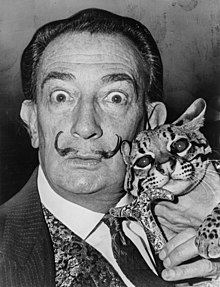Babou (ocelot): Difference between revisions
Undid revision 1222607137 by 2A00:23C8:D017:3100:7DEF:3821:7E45:D6A9 (talk) - seems to introduce an error into the page (along with its predecessor) |
Undid revision 1222607039 by 2A00:23C8:D017:3100:7DEF:3821:7E45:D6A9 (talk) - seems to introduce an error into the page |
||
| Line 3: | Line 3: | ||
{{Use dmy dates|date= May 2022}} |
{{Use dmy dates|date= May 2022}} |
||
{{Use British English|date= May 2022}} |
{{Use British English|date= May 2022}} |
||
[[File:Salvador Dali NYWTS.jpg|thumb|alt=Salvador Dalí with his pet ocelot, Babou, 1965|Salvador Dalí ( |
[[File:Salvador Dali NYWTS.jpg|thumb|alt=Salvador Dalí with his pet ocelot, Babou, 1965|Salvador Dalí (left) and Babou (right), 1965]] |
||
'''Babou''' was a pet [[ocelot]] and frequent companion of the surrealist artist [[Salvador Dalí]] in the 1960s. A cat lover, Dalí claimed to have been given the animal by the head of state of Colombia. Babou's date of death is unknown. |
'''Babou''' was a pet [[ocelot]] and frequent companion of the surrealist artist [[Salvador Dalí]] in the 1960s. A cat lover, Dalí claimed to have been given the animal by the head of state of Colombia. Babou's date of death is unknown. |
||
Revision as of 04:19, 7 May 2024
The topic of this article may not meet Wikipedia's general notability guideline. (May 2022) |

Babou was a pet ocelot and frequent companion of the surrealist artist Salvador Dalí in the 1960s. A cat lover, Dalí claimed to have been given the animal by the head of state of Colombia. Babou's date of death is unknown.
Life with Dalí
In the 1960s, Babou was frequently seen with Dalí, who claimed to have been given the wild ocelot by the head of state of Colombia.[1] Dalí had always been a cat lover[2] and had an interest in exotic animals. He enjoyed a visual pun and would sometimes wear a cat pattern or coloured coat when travelling with Babou.[3] In 1969, he was photographed leaving a Paris metro station with an anteater on a lead.[4]
For a time in the 1960s, Babou was more often than not accompanied by Dalí. In a restaurant in Manhattan, although Babou's leash was tethered to the table, a fellow diner became quite alarmed until Dalí assured her that Babou was an ordinary cat “painted over in an op art design."[1][5][6] On another occasion, when Babou and Dalí were visiting a gallery in Paris, Babou "made a nuisance" on some valuable 17th-century lithographs. Dalí claimed that the connection with him could only increase their value and the dealer increased the price of the lithographs by 50%. Dalí also agreed to sell the dealer a batch of his lithographs to placate him.[3]
In 1970, Robert Wernick reported in Life magazine that Babou had a younger companion named Bouba who were led into the hotel Meurice on a leash by one of Dali's assistants and made sick by the hotel's revolving doors.[3] The Meurice was a luxury hotel in Paris since 1815, where Dalí was a regular guest for 30 years in its best known suite, the Royal Suite, which had been home to King Alfonso XIII during his exile from Spain.[7] Writing in his memoirs, the actor Carlos Lozano (a friend of Dalí) stated, “I only saw the ocelot smile once, the day it escaped and sent the guests at the Meurice scurrying like rats for cover.”[1][8]
Babou also accompanied Dalí on a transatlantic crossing on the SS France.[9][10]
Legacy
In the American adult animated sitcom Archer (2009–2023), one of the principal characters, Cheryl Tunt, has a pet ocelot named Babou.[11]
References
- ^ a b c Woodward, Daisy (23 January 2013). "Salvador Dalí's Ocelot". AnOther magazine. Retrieved 7 May 2022.
- ^ "Salvador Dali". The Great Cat. 11 November 2016. Retrieved 7 May 2022.
- ^ a b c Inc, Time (24 July 1970). "LIFE". Time Inc – via Google Books.
{{cite web}}:|last=has generic name (help) - ^ "Surrealists and Their Pets". Sotheby's. 15 March 2018. Retrieved 7 May 2022.
- ^ Rothman, Lily (11 May 2015). "See 10 Great Artists With Their (Also Great) Cats". Time magazine. Retrieved 7 May 2022.
- ^ Vincent, Alice (23 January 2014). "11 surreal facts about Salvador Dalí". The Daily Telegraph. Retrieved 7 May 2022.
- ^ Gubler, Fritz (25 December 2008). Waldorf hysteria: hotel manners, misbehaviour & minibars. Great, Grand & Famous Hotels. p. 18. ISBN 978-0-9804667-1-3. Retrieved 7 May 2022.
- ^ Burca, Jackie De (25 October 2018). Salvador Dali at Home. White Lion Publishing. ISBN 9780711239432 – via Google Books.
- ^ Lime, H. Salvador Dali : The Master Surrealist. Lulu.com. p. 28. ISBN 9780244494629. Retrieved 7 May 2022.
- ^ "Salvador Dali's Pet Ocelot". Suddenchic. 4 August 2016. Retrieved 7 May 2022.
- ^ Kim, Anna (3 March 2020). "What was Babou in Archer?". The Burning of Rome. Retrieved 7 May 2022.
